I. Introduction
Generating a mixture of subtypes to represent the patient;
Creating a distribution of symptoms for each subtype;
Choosing a subtype based upon the mixture of subtypes; and
Choosing a symptom based upon the subtype’s distribution.
II. Methods
1. Study Setting and Population
2. Measures and Outcomes
Table 1
Table 2
3. Analyses
1) LDA models
Figure 1
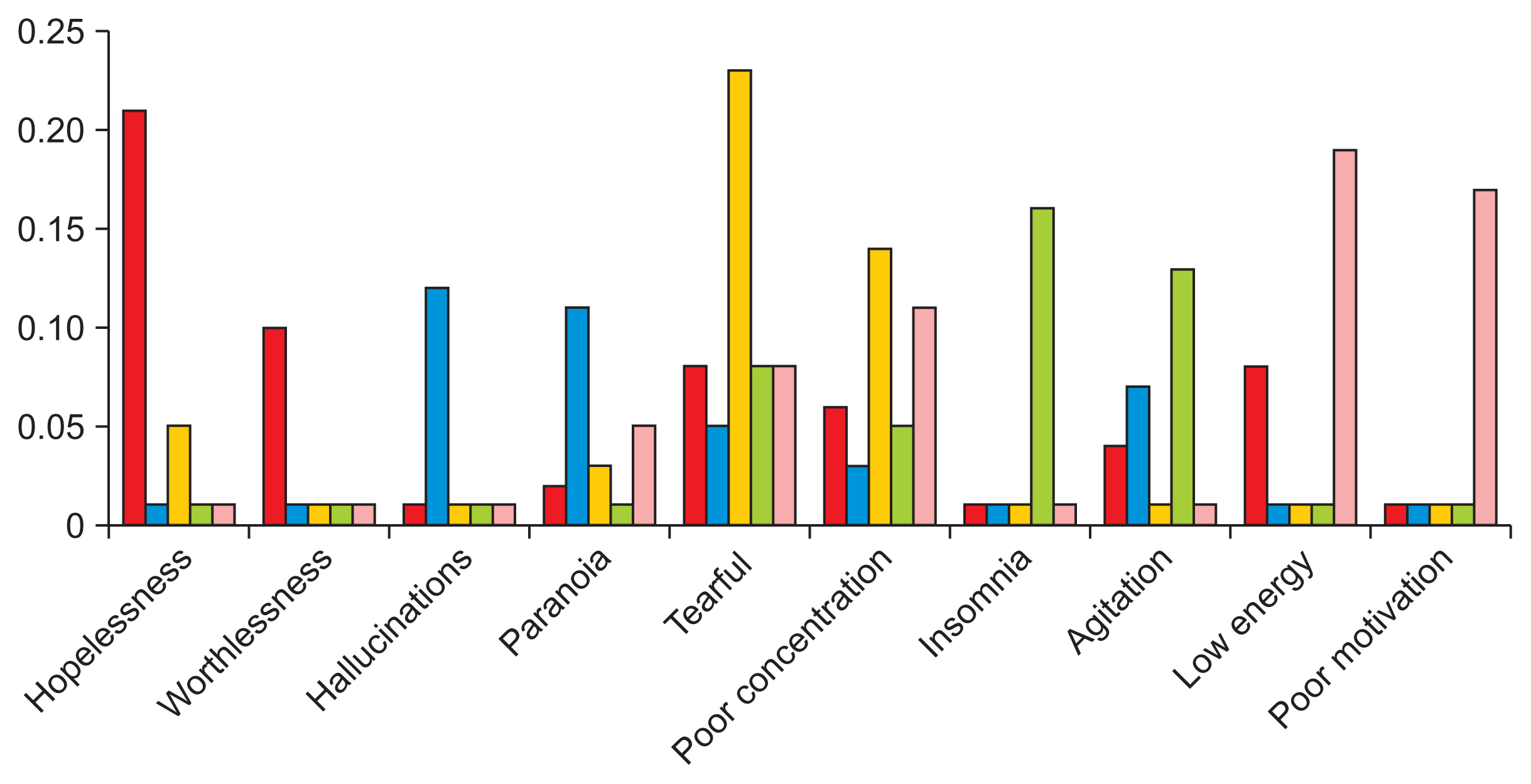
2) Latent class analysis models
Figure 2
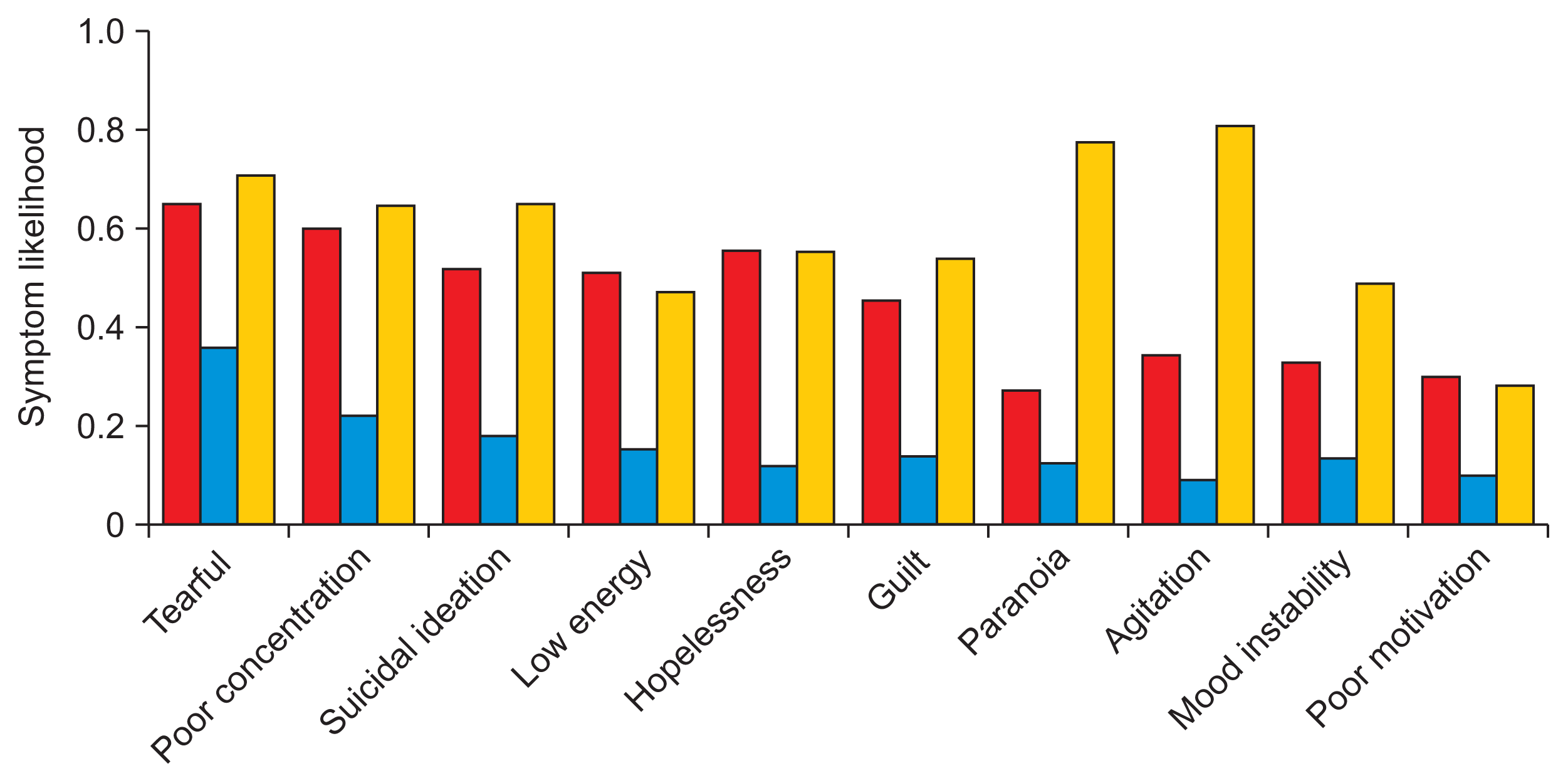
III. Results
1. Clinical Outcomes
Table 3
| Psychotic | Severe | Mild | Agitated | Anergic | |||
|---|---|---|---|---|---|---|---|
| LDA | Emergency presentations | OR (95% CI) | 1.29 (1.17–1.43) | 1.16 (1.05–1.29) | 0.86 (0.78–0.94) | 0.83 (0.75–0.92) | 1.01 (0.91–1.13) |
| p-value | <0.001* | 0.01* | <0.001* | <0.001* | 0.83 | ||
| Crisis events | OR (95% CI) | 2.45 (2.15–2.80) | 1.14 (0.98–1.33) | 0.49 (0.41–0.57) | 0.96 (0.86–1.13) | 0.64 (0.54–0.78) | |
| p-value | <0.001* | 0.08 | <0.001* | 0.82 | <0.001* | ||
|
|
|||||||
| Psychotic | Severe | Moderate | Mild | ||||
|
|
|||||||
| LCA | Emergency presentations | OR (95% CI) | 4.16 (3.50–4.95) | 5.26 (4.58–6.05) | 0.84 (0.74–0.95) | 0.27 (0.23–0.31) | - |
| p-value | <0.001* | <0.001* | <0.001* | <0.001* | |||
| Crisis events | OR (95% CI) | 1.32 (1.12–1.56) | 1.62 (1.43–1.84) | 1.12 (1.03–1.22) | 0.71 (0.65–0.77) | - | |
| p-value | <0.001* | <0.001* | <0.001* | <0.001* | |||
Table 4
| Scale | Total (n = 18,314) | Psychotic (n = 3,059) | Severe (n = 3,140) | Mild (n = 4,844) | Agitated (n = 4,291) | Anergic (n = 2,980) | p-valuea |
|---|---|---|---|---|---|---|---|
| Agitation | 1,397 (7.6) | 442 (14.4) | 180 (5.7) | 282 (5.8) | 358 (8.3) | 135 (4.5) | <0.001 |
| Self-injury | 2,624 (14.3) | 490 (16.0) | 612 (19.5) | 561 (11.6) | 623 (14.5) | 338 (11.3) | <0.001 |
| Drug misuse | 1,403 (7.7) | 290 (9.5) | 261 (8.3) | 327 (6.8) | 329 (7.7) | 196 (6.6) | 0.01 |
| Cognition | 1,328 (7.3) | 364 (11.9) | 193 (6.1) | 286 (5.9) | 289 (6.7) | 196 (6.6) | <0.001 |
| Physical illness | 3,846 (21.0) | 693 (22.7) | 696 (22.2) | 954 (19.7) | 890 (20.7) | 613 (20.6) | 0.06 |
| Hallucinations | 1,178 (6.4) | 699 (22.9) | 119 (3.8) | 94 (1.9) | 179 (4.2) | 87 (2.9) | <0.001 |
| Depressed | 9,063 (49.5) | 1,634 (53.4) | 1,616 (51.5) | 2,243 (46.3) | 2,033 (47.4) | 1,537 (51.6) | <0.001 |
| Relationship | 3,685 (20.1) | 709 (23.2) | 691 (22.0) | 925 (19.1) | 822 (19.2) | 538 (18.1) | <0.001 |
| Daily living | 3,130 (17.1) | 635 (20.8) | 553 (17.6) | 689 (14.2) | 726 (16.9) | 527 (17.7) | <0.001 |
| Living conditions | 1,714 (9.4) | 391 (12.8) | 355 (11.3) | 363 (7.5) | 347 (8.1) | 258 (8.7) | <0.001 |
| Occupational | 3,304 (18) | 676 (22.1) | 619 (19.7) | 728 (15.0) | 750 (17.5) | 531 (17.8) | <0.001 |
| HoNOS missing | 10,704 (58.4) | 2,027 (66.3) | 1,798 (57.3) | 2,680 (55.3) | 244 (57) | 1,751 (58.8) | <0.001 |
Table 5
| Scale | Total (n = 18,314) | Psychotic (n = 987) | Severe (n = 1,596) | Moderate (n = 6,063) | Mild (n = 9,668) | p-valuea |
|---|---|---|---|---|---|---|
| Agitation | 1,397 (7.6) | 242 (24.5) | 245 (15.4) | 426 (7) | 484 (5) | <0.0001 |
| Self-injury | 2,624 (14.3) | 195 (19.8) | 619 (38.8) | 1,043 (17.2) | 767 (7.9) | <0.0001 |
| Drug misuse | 1,403 (7.7) | 95 (9.6) | 266 (16.7) | 490 (8.1) | 552 (5.7) | <0.0001 |
| Cognition | 1,328 (7.3) | 197 (20) | 126 (7.9) | 413 (6.8) | 592 (6.1) | <0.0001 |
| Physical illness | 3,846 (21.0) | 210 (21.3) | 333 (20.9) | 1,279 (21.1) | 2,024 (20.9) | <0.0001 |
| Hallucinations | 1,178 (6.4) | 401 (40.6) | 216 (13.5) | 251 (4.1) | 310 (3.2) | <0.0001 |
| Depressed | 9,063 (49.5) | 599 (60.7) | 1,137 (71.2) | 3,170 (52.3) | 4,157 (43) | <0.0001 |
| Relationship | 3,685 (20.1) | 274 (27.8) | 519 (32.5) | 1,268 (20.9) | 1,624 (16.8) | <0.0001 |
| Daily living | 3,130 (17.1) | 257 (26) | 330 (20.7) | 1,072 (17.7) | 1,471 (15.2) | <0.0001 |
| Living conditions | 1,714 (9.4) | 153 (15.5) | 236 (14.8) | 598 (9.9) | 727 (7.5) | <0.0001 |
| Occupational | 3,304 (18) | 255 (25.8) | 446 (27.9) | 1,118 (18.4) | 1,485 (15.4) | <0.0001 |
| HoNOS missing | 10,704 (58.4) | 233 (23.6) | 369 (23.1) | 2,530 (41.7) | 4,490 (46.4) | <0.0001 |




 PDF
PDF Citation
Citation Print
Print



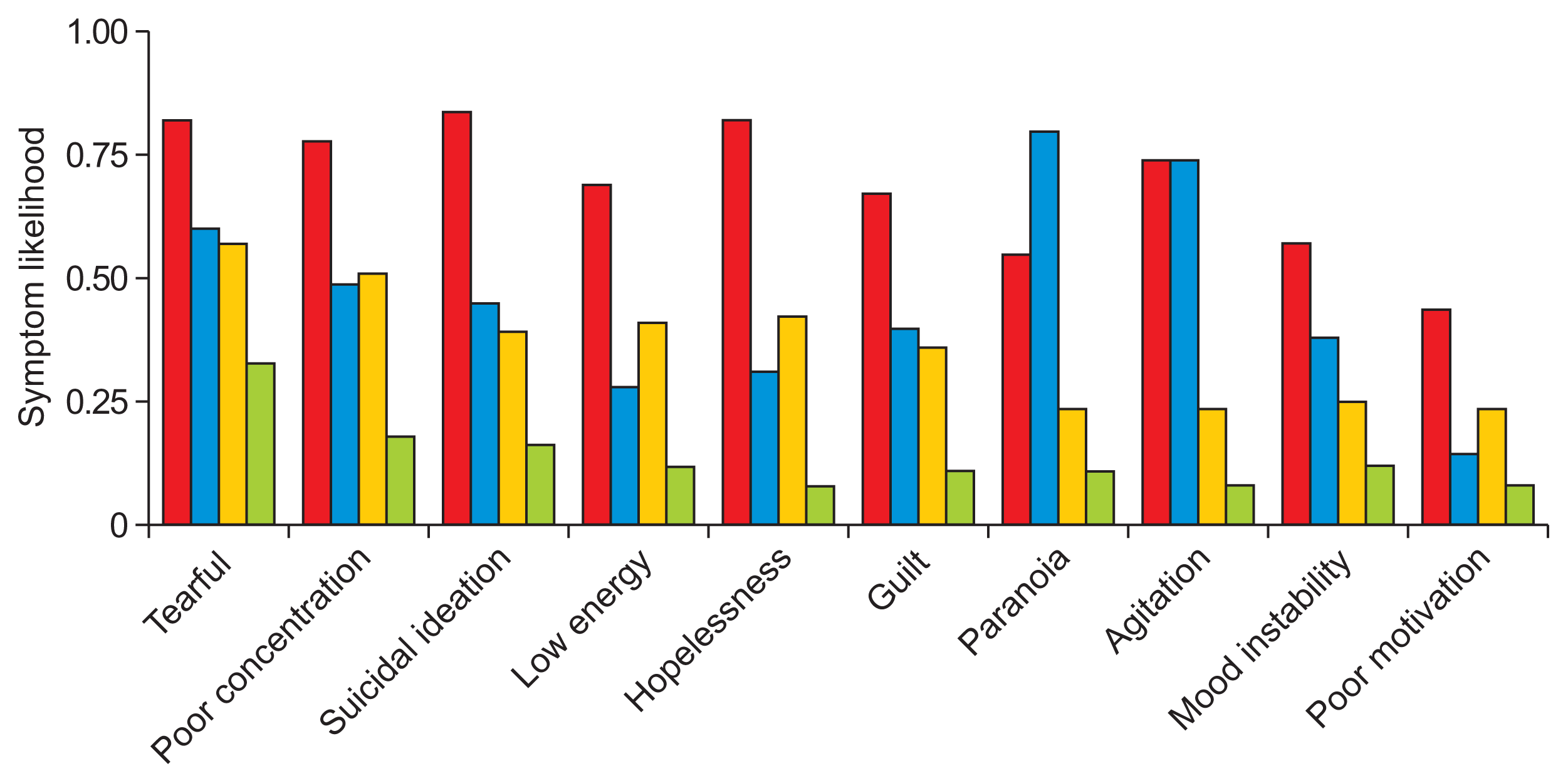
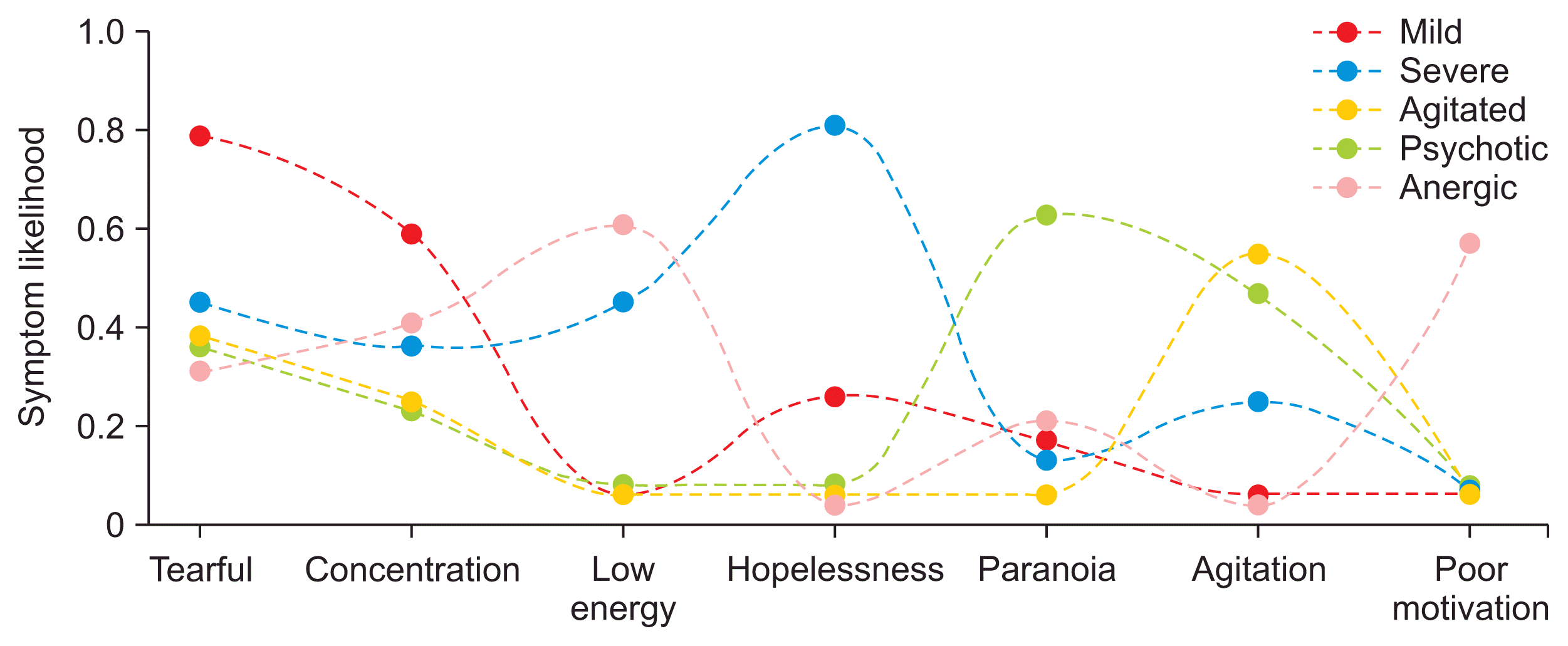
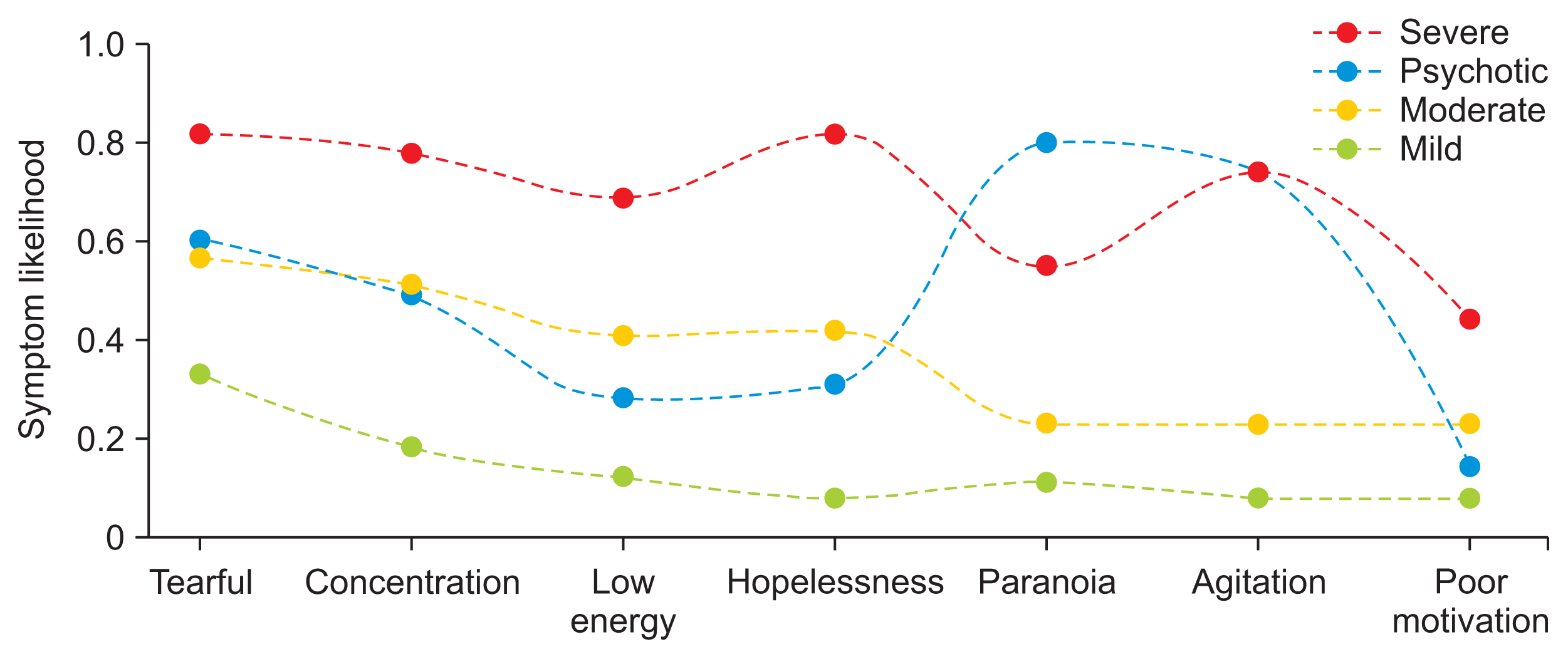
 XML Download
XML Download